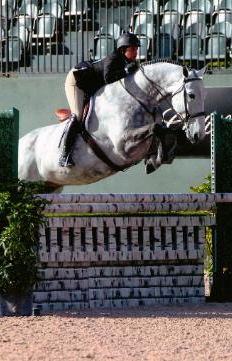Despite its reputation, horse riding is not a fraudulent sporting activity

More stories from Eva Harshman

A showjumper from a local barn, Meadowview Farm
Whenever somebody asks me what sport I do, I answer with the sole extracurricular I take part in: horseback riding. Their response about fifty percent of the time is the uneducated “horse riding isn’t a sport” or “the horse does all of the work.”
As someone who has been riding and around other riders starting when I was about seven years old, I can tell you that anyone who has everyone ridden a horse for purposes other than leisure, including myself, does indeed believe that horse riding is a sport. It’s not just any sport; oftentimes it can be difficult and even risky.
To begin with, horse riding is included in the most widely-known sporting event—the Olympics—and has been since 1900. It takes the spot of not just one but three events, those being dressage, three-day eventing, and show jumping. If something is in a sporting event, it is considered a sport, especially if it is in there loud and proud three times unlike curling, which is crammed among the many games.
In addition to being in the Olympics, horse riding takes a degree of athleticism you would only understand with a close eye or upon the back of an equine. From two-pointing (holding oneself up out of the saddle) over towering jumps to staying seated in the elaborate dressage saddle during a trot, many positions most would see as awkward or uncomfortable are normal for equestrians.
Of course, these come naturally to the well-seasoned rider, as over time, they have had to build up muscle in their calves, thighs, pelvis, abs, and many other locations. While people make the claim that the horse is doing the work by walking, trotting, cantering, or jumping, they are ignoring the fact that not all sports are driven by cardio. The muscle-building exercise from riding a horse is unlike any other sport but is nonetheless physically demanding.
As well as needing muscle and athletic ability, equine sports also require an ability to make decisions in a split second and having precise movements.
When approaching a jump, the rider needs to consider how soon to turn, how deeply to canter into a corner and the speed at which they must approach it. In a scenario in which other horses are in the arena, a rider must determine how closely they can pass another horse without causing spooking between the two.
In the event that they fall, an equestrian has to quickly react in a way that will avoid spooking the horse as much as possible while protecting themselves. If a rider is unable to make a decision in an efficient manner, the results could include a drastically lower score or even an injury to one or more horses or riders.
This brings in the danger and risk involved in sports involving a horse. Every rider has experienced being thrown from their seat far more than once in their life. While there are many steps to take for protection, there is still always the chance that something detrimental could happen.
Two teenage girls passed away two months apart on a cross-country riding event. They, unfortunately, experienced a rotational fall, in which the horse falls over the jump in a somersault way, landing on their back. This is definitely one of the most dangerous falls, and many riders who participate in cross-country events on horseback are putting both themselves and their horses at risk. In order to keep themselves safe, riders must have the coordination to keep the horse and themselves balanced while jumping high enough as not to trip.
To the untrained eye, horse riding may just look like a person sitting back like royalty while letting a horse leap over obstacles. In reality, the sport requires much strength, patience, and precision. So, if someone believes that horse riding is not a sport, they clearly need to rethink how much of a “sport” anything else is.

Eva Harshman is a senior who is thrilled to be entering her fourth and final year on staff as Editor-in-Chief. Apart from writing for The Central Trend, she...
























































































